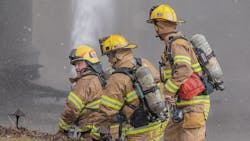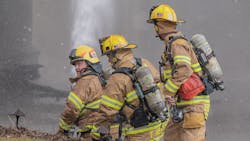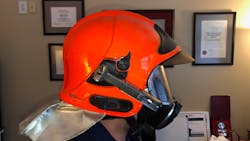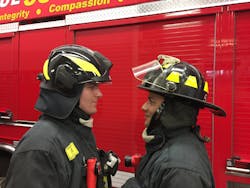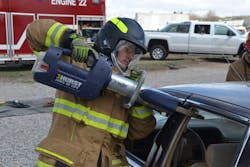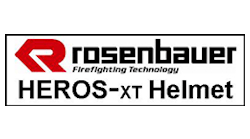Fire Helmets in the U.S. - Traditional vs. European
Firehouse asked members from one Washington fire district—accustomed to adopting international firefighting practices—to share their experiences from a trial period using the jet-style helmets found in Europe.
Ed Hartin, fire chief with Central Whidbey Island, WA, Fire & Rescue
I grew up in the fire service watching my father and other members of the Wayland, MA, Fire Department wearing tin and then leather helmets. Entering the career fire service in 1974 with the Concord, MA, Fire Department, I was originally issued an MSA Topguard helmet (just like those worn by Johnny and Roy in the TV show “Emergency”). I was not particularly impressed with this helmet as it was made of thin thermoplastic with a suspension system like what you would find in a construction hard hat. As the fire chief at the time did not mind if we wore a different helmet, I bought a used leather helmet (back in the day where there was no suspension system) and wore that until 1983 when I was promoted to captain when I was issued a Cairns 660C “modern” helmet. My new helmet was as light as my old leather one but had a suspension system that provided improved impact protection. From 1983 to 2009 I wore similar helmets while serving with three different fire departments in Massachusetts, Pennsylvania, and Oregon.
In the mid-2000s, I began attending training and teaching in Asia, Europe and South America. This provided exposure to a wide range of the other types of firefighting head protection. Working from the perspective of “when in Rome, do as the Romans” I enjoyed the opportunity to work in different types of PPE, from hooded turnouts in Sweden to jet-style helmets with clip-on SCBA facepieces in Belgium. From my own experience and talking with firefighters from around the world, I became impressed with the level of protection and functionality of the jet-style helmets and even more so of clip-on SCBA facepieces.
Assuming the role of fire chief with Central Whidbey Island, WA, Fire & Rescue (CWIFR) in 2009, I purchased a traditional-style Cairns fire helmet like those purchased by the fire district as part of a complete replacement of PPE completed in 2007. While I would have been quite happy to wear a European jet-style helmet, I was quite aware of the attachment that firefighters have to what is on their head and as the fire chief I had more pressing issues to deal with.
After a trip to Belgium, I brought back a clip-on SCBA facepiece from Dräger and showed our members how this reduces facepiece donning time. The only question I received was: “When are we getting these”? I explained that this style of facepiece attachment would not work with our traditional style helmets and was not approved for use in the U.S.In 2017, Capt. Jerry Helm approached me with a request to trial a demo model Rosenbauer HEROS-xt helmet. I thought his request was interesting as prior to my appointment as fire chief in 2009, he led the charge to convert to traditional-style helmets. After his brief opportunity to wear this helmet on a day-to-day basis, he advocated to conduct a more thorough 90-day trial by purchasing 10 Rosenbauer HEROS-titan Pro for use by members across the organization.
Jerry Helm, training and recruitment captain, Central Whidbey Island Fire & Rescue
As a young boy who grew up in the fire station with his dad, I loved wearing my father’s fire helmet. At that age I had no clue of the importance of the components or the practicality of a helmet. I only knew I loved it because it was a representation of my father and it even smelled like him. I associated that helmet as a symbol of my father. When I was finally old enough to earn my own, I took great pride in my helmet.
After a few years I realized that my Cairns 660C metro-style helmet wasn’t really what I wanted to wear on my head. Looking back, the only reason I longed for a traditional-style helmet was because of the look. In 1991, when the movie “Backdraft” came out, I wanted to be just like them. Learning that ¾-length boots were no longer compliant or even available, the next best thing was the helmet. I lead a department-wide evaluation and championed for the switch from modern-style fire helmets to traditional-style helmets, inclusive of the switch from tan to PPE. I felt like I had finally made it when we made the switch. I had finally become a “real” firefighter.
As I gained more experience, I noticed that my priorities began to switch ever so slightly. I no longer held such a high regard for the iconic traditional helmet with its golden eagle mounted on the top. I started to notice the shortcomings of all my PPE, not just the helmet. Firefighters were complaining of sore feet, so we looked into leather boots. Suspenders were not lasting very long, so we researched more about leather suspenders. Gloves are a constant issue, and we still exploring options. When I started to hear about issues with the helmets, particularly neck injuries and the lawsuits that were tied to them, I suggested we look at the possibility of different helmets just as we do for the other components of PPE that we find issues with. Almost as soon as it was suggested, there was a mounting opposition against it. I was intrigued with why the helmet got such an emotional reaction to a possible positive change.I looked at many different styles of helmets, and the newest one to hit the market at the time was the Rosenbauer HEROS-xt. This was my very first exposure to a European-style helmet. I found the helmet substantially lighter (only 3.3 pounds), and in my opinion, it performed better, particularly in diminished clearance or entanglement situations. An added benefit was the ability to look up while crawling during search and rescue in low-visibility situations. Unfortunately, this helmet was a demo that had to be returned to the vendor, but from that point on I was sold on the performance.
A few months later, I received a picture of the new Rosenbauer HEROS-titan Pro being introduced at the Interschutz trade show in Germany. I was immediately impressed by the design and the improvements I noticed over the predecessor I had worn. I checked with the local representative but learned that it was not available yet. Eventually, through some substantial investigation and inquiry, we found some a few years later.
Central Whidbey Island Fire & Rescue’s transition
In 2017, CWIFR decided to conduct a field trial of the Rosenbauer HEROS-titan Pro fire helmet that was being tested to meet NFPA 1851 – Standard on Selection, Care, and Maintenance of Protective Ensembles for Structural Fire Fighting and Proximity Fire Fighting (NFPA, 2014). After the testing process and shipping time from Austria to the distributor in Wisconsin and on to Whidbey Island, 10 new helmets were received. Since the district is staffed with a combination of full-time, part-time and volunteer firefighters, we divided the helmets among these three categories of members and across ranks from firefighter to fire chief.
Over a period of three months members assigned the HEROS-titan Pro were asked to provide feedback on their assessment of this jet-style helmet in comparison to the Morning Pride Ben II helmet that was in use by the district. At the conclusion of the three-month trial, evaluation of the feedback indicated that the comfort, balance, weight, eye protection, and overall performance of the HEROS-titan Pro was superior. While overall performance was perceived as better, some members indicated that they experienced some reduction in hearing due to their ears being fully covered by the helmet, but other members did not find it to be significant. Several others simply preferred the traditional look of the Ben II.
Based on the results of this field trial, CWIFR began the process of conversion to the Rosenbauer HEROS-titan Pro as the standard issue helmet. Replacement is being implemented as existing helmets reach the end of their 10-year life span.
The district is committed to continuous improvement and has adopted several concepts and tools from around the world including smoke cooling and anti-ventilation before fire control from Sweden (and supported by research conducted by Underwriters Laboratories); door curtains from Germany; and fog nails from Sweden. While we look beyond our borders, we also embrace the best of what can be found in the U.S. fire service as well. No one nation or fire service agency has all the answers. Best practices can be found across the world in small agencies and large, if we only look for them.Managing Change in the Fire Service
By Jason Caughey
The American fire service is built on tradition. Traditions like valor, honor, integrity and pride are the root of the service that we provide our communities. We can lose track or confuse traditions with image or “the look” of traditions. If you want to test the theory, just bring up what color apparatus should be, or what nozzle to use or if you really want a fight, ask what helmet to wear. Any one of these topics will guarantee you a heated and passionate discussion.
One of the hot topics today is helmets—traditional or European? The traditional helmet is an iconic image of the American fire service. But, is it about the helmet or the image? How does performance and safety fit into the decision to change helmets? Is it about the helmet or have we changed so much that we must press pause and let all the changes settle in?
The question today is how do we continue to advance the fire service past our traditions? If you look back at our history, many of the hot topics that we argue over haven’t always been a tradition. Think about it, before Hugh Halligan developed the Halligan tool the fire service tradition was the claw tool or Kelley tool. Before George Hurst patented the first hydraulic rescue tool the tradition was hand saws, porta powers and hammer and chisels. The point is what we consider a traditional tool was, at one point, a controversial new tool. This raises the thought that if we were truly a traditional fire service, we would still be utilizing the bucket brigade.
As Chief Alan Brunacini used to say, “Firefighters hate two things, the way things are and change.” This may be true but if you look at all that the fire service has changed over the last 50 years, we are actually very good at changing.
Keeping an open mind
So how do you manage change? How do we test research and keep an open mind on new technology and research? Recently my department took a serious look at the European-style helmet and our goal was to keep an open mind while examining the advantages and disadvantages associated with our helmets. The following describes the approach we took when assessing the helmets.
For this test we conducted wear tests on two European-style helmets—the MSA XF1 and the Rosenbauer-titan Pro.
To begin with, we addressed the elephant in the room…the look of the helmet. Before we conducted a single test, we wanted an open discussion about the appearance. We started this with discussing why are the traditional helmets designed the way they are and why are European helmets designed the way they are. The large brim on the American helmet was designed to prevent embers and debris from sliding down our neck. Before we wore hoods and had high collars on turnout coats, the helmet brim was the only protection for the back of our neck. The crown and ribs of the helmet were the method to sew the panels of leather together. Today those ribs give some compression support, but truly are for looks.
The question becomes, are those features necessary today?
The European helmet is designed to integrate with an SCBA facepiece, limiting the amount of exposure around the face and head from heat. The European helmet removes the large brim to allow for more contoured interphase between the turnout jacket collar and SCBA bottle and pack making it less restrictive.
When we started to define why each helmet was built the way it was, and the history behind the design, we were able to open the minds of our firefighters. With that said, the pure look of the helmet was, and still is, a hot topic.
Wear testing
The next step for us was to define what we needed in performance of our helmet. When we took the “look” out of the equation we came up with three goals for our test: fit, comfort and performance.
We asked members to address the fit of the helmet with and without an SCBA. To test fit, we had members perform two fire service tasks: extrication and interior fire attack.
The comments about European-style helmets following the extrication scenario included that the eye protection was built-in and easy to use, the firefighter didn’t have to take the helmet off to crawl into the vehicle for patient assessment and one member’s neck and head did not hurt after wearing the helmet for an extended period of time.
Following the fire attack scenario, firefighters said there was improved mobility when crawling in the burn building with SCBA on and that there was less fatigue and pressure on their head. The design was said to be agile and streamlined, allowing for faster donning of the helmet and facepiece and the “fit with the SCBA mask was super comfortable.”
During the testing process we also wanted to address the accessory options of both a traditional and European-style helmets. We focused on three accessories: eye protection, lighting systems and radio interphase.
The XF1’s integrated lighting system features lights on both sides of the face with pinpoint accuracy of the stream providing light to where your eyes were looking. The on/off switch was difficult to access with gloves and decontamination was difficult.
The Titan Pro’s integrated lighting system was mounted on top of the helmet and allowed the light to shine down into the work area, but the high setting was extremely bright. The on/off switch was easy to manipulate, and decontamination was easy.
Both integrated light systems were noticeably better than our traditional exterior mounted flashlights.
Both European helmets were fitted with two forms of integrated eye protection: full face shield and eye shield. The systems were integrated into the helmets and allowed for streamlined use and the eye shield was simple and easy to use during the extrication scenario. The eye protection did not snag on any objects, but decontamination was challenging.
Both European helmets had the ability to have integrated speakers and boom microphones built into them.
We tested a protype of the XF1 and the benefit of a speaker over your ear was dramatically noticed during both tests. The ability to hear the radio was improved greatly, but there was some reduction in ambient noise which was both good and bad. The boom microphones were bulky with and without the SCBA facepieces.
Post-test findings
After completing all our testing, the question became, “Which helmet was right for our organization?” I think this was one of the most important questions we had to address. When we looked at the performance, it was overwhelmingly noticeable that the European helmets through design and features outperformed our current helmets. Both traditional and European helmets meet the same safety standard. We assume the lighter helmet and more ergonomic helmet would be safer, but the data is not there yet to validate that statement.
So, making the change or not to a European helmet became a battle about features and how those features fit our needs. One of the statements made during this process was, “Can we have two helmets?” The idea was to have the traditional for everyday use and public function, but the European-style helmet for working fires. I think that statement summarized where our organization stood regarding helmets.
My recommendation is that it is our responsibility to look at all technology and test it at the local level. See if it fits your community’s needs, organizational needs and operational needs. Test the technology to see if it works for you, then let the results help you identify if you should adopt it. Not all fire departments have the same needs. Our organization determined that having either our traditional helmet or European helmet would be determined on an individual basis.
Bio
Jason Caughey is the fire chief of Laramie County Fire District #2 in Cheyenne, WY, and an adjunct professor for Laramie County Community College, where he teaches on the principles of fire behavior. Prior to arriving in Cheyenne in 2011, he was the fire chief of Gore Hill Fire Rescue in Great Falls, MT. He also spent 10 years working for the Montana Fire Services Training School as a regional instructor and regional training manager for the state of Montana. Caughey has been an active member in “Kill the Flashover” and served as a technical member of the UL Positive Pressure test committee and a lead instructor for the Ottawa Project “Knowledge to Practice.” Caughey has a bachelor’s degree in fire science from Columbia University.

Edward Hartin | Editoral Staff
Ed Hartin, MS, EFO, FIFireE, CFO has over 40 years as a career firefighter and fire officer and currently serves as fire chief with Central Whidbey Island Fire & Rescue. Hartin is also a member of the UL Firefighter Safety Research Institute Advisory Board and vice president of the USA Branch of the Institution of Fire Engineers.
